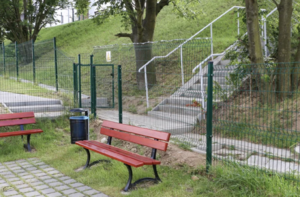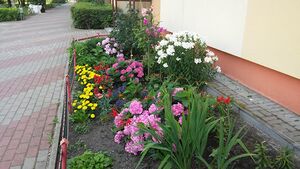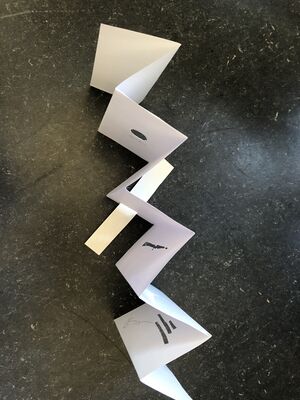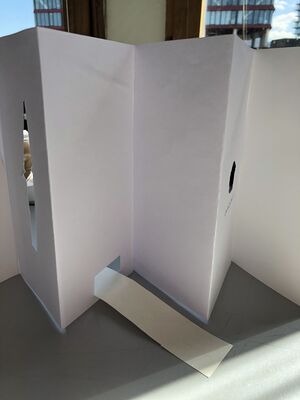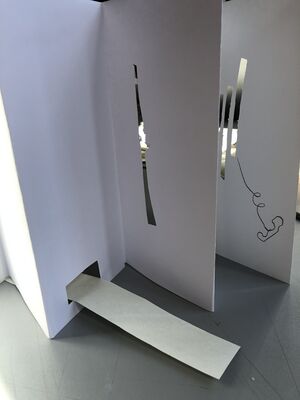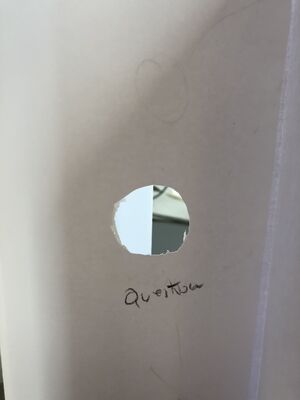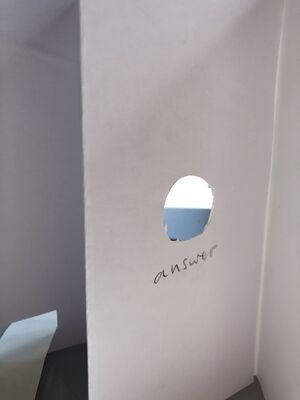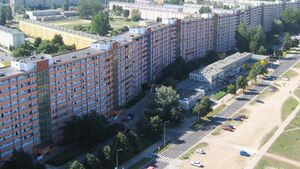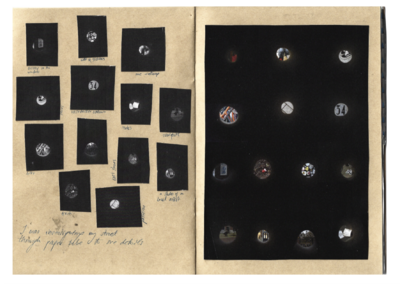User:Mania/Project That May or May Not Be Made template
Fences and borders - proposition 1
What is it? - propisition 1
Project about fences and bordesr in poublic space.
It will be an instalations which would be a result of a field research, analysing functionality of forms encountered in public space with a focus on delineating territories and borders in urban space.
Accompanying publication with a reserach process, that has the same shape as imstalation.
Why make it?
In Poland, gated communities were a promise of paradise. Some people still want to separate themselves, but there are also different expectations towards the city, the need for a more public space than a privatized one.
Workflow
First trimester, research and writing Secon trimestre prototyping, testing, ( by this time writing fonished) 3 trimester - building
Rapid prototypes
Paper prototype Interaction between people from both sides. In order to engage with the instalation you need someone from the other side. there is a swing that requires people from both sides to play, there is a "telephone receiver" so you can hear sounds that someone is sending from th eother side, answer to the question from one side is on the other side, and so on...
Previous practice
Reference to previous spetial projects,
research will include organising walks woith people and collecective drawings.
Relation to a wider context
- The context of determining areas and boundaries in urban space and housing complexes.
- Interest in the phenomenon of residential architecture ,for instance the wave-shaped block (Pol. falowiec) in Gdańsk
- common spaces, communication, functionality
- What role is imposed on users by such architecture?
- equal access to public space
Choices made
Interaction between people from both sides. In order to engage with the instalation you need someone from the other side.
inspirations, propositions from others:
https://sabukaru.online/articles/to-share-a-cup-of-tea-with-pierre-sernet
nolli map
psychogeography
Quick proposal - children book - proposition 2
What is it?
A children's book explaining how photography works… with different pieces you can build a camera obcura. And accompanying website for parents explaining how not to ruin the experience of the book for kids…
Book that includes parts that can be used to build a camera obsura, or a book itself can be unfolded and become a camera ...
Why make it?
Becasuse it looks like some children's books are designed not for children but for parents, to buy them.
Workflow
Timetable
Rapid prototypes
Previous practice
Relation to a wider context
- Explaining how things works
- Learning by doing
Choices made
Task book, to make, build things and play
A website - looks almost like a mannual, super simple steps to follow almost like how to build a ikea furniture
How to turn a room into a camera obscura? - proposition 3
What is it? (physical description )
- A big camera obscura instalation to which you can walk in -> transforming a room (for example acquarium on 4th floor) into a camera obscura.
- Several smaller cameras made from different objects for instance cans - Publication bringing together photographs made in the process
Why make it?
But why to do it if we are surrounded by high tech tools to take photographs?We may take things for granted, we click play and we have music playing, we click the button on our smartphones and we take a picture. But what really enables the image to be preserved? I use the everyday objects as tools for playing with wanders of physical world and explaing concepts that are difficult to understand when stated verbally.
Explain while actively demonstrating how a camera obscura works and how objects such as a folded piece of paper, can or a box, can tap into properties of light to produce a photograph. Any kind of dark room can become a camera obscura , if you block out the ligh completely and only cut a small opening to allow light to come in.
Workflow
Organise a workshop - 'make your own camera obscura '
Experiment with DIY cameras
Work on a publication to gather the whole material
Final instalation- how to turn a room into a camera obcsura
Rapid prototypes
Light enters the box through a lens set into the opening and projects an image onto the opposite surface. The image is upside-down and backwards.
Step 1: Gather your supplies.
Step 2: Make the screen. Cut the piece of white paper to fit one side of your box; use the tape to attach it to the inside.
Step 3: Make some holes!
Step 4: Close it up, tape it shut.
Step 5: Try it out!
Previous practice
Relation to a wider context
Learning by doing
playing with wanders of physical world
What we choose to capture ( Remembering and forgeting)
Archival practice
see also: https://monoskop.org/images/3/34/Crary_Jonathan_Techniques_of_the_Observer_1990.pdf
In the city there's a thousand things I want to say to you - proposition 4
"In the city there's a thousand things I want to say to you"- The Jam, In the City (1997)
Concept:
The project starts from a concept that an urban environment can be read, analyzed and criticized as a text. By aimlessly wandering and drifting we can name exactly what we see. List making can make very explicit what is missing, and who is not present or what is succesfully hidden. If the city can be read it can also be annotated, and it's an inspiring concept for me. Posters, newspapers, graffittis, clothing, performances in public squares serve as footnotes, annotations with very diverse comments.
What is it? (physical description )
Its a device to read the city and to write it anew. It has a shape of binacular or a tube, its subtle and can be carried with you and accompanny your walk.
The build in sensors send information to the browser, that generates a walking script for you based on the previuosly selected character. Therefore a person interacting with the device can step outside of themselfe and expeirence the space from the perspective of other. It's not meant to explore new routes, but rather to engage with a familiar space within a very differnt context.
Words that could transmit a unique perspective of a given person on a particular space. —-> They act as a guide through the space.
There are diffrent types of walks and routes:
• The daily route
• The adventurous route
• The route you never walked before
• The route to clear your mind
• The evening slow walk
• The Sunday stroll
• The routine route
• The route to the nerest supermarket
• The safer route
• The visitor route
• The local route
• The I’m not in a hurry route
• The date walk
Choose a route, and a character
Another part of the project is a wearable walking suit, with several parts that can be diconneceted, and exchanged with other pedestrians, encouraging to talk to starngers. Words printed on suit serves as a walking manifesto.
Im fascinated by printed matter, so I would also like to have a riso printed publication with many walking scripts. Or a Collection of tiny zines.
Why make it?
In a smart city ruled by obsession with perfection, maintenence and efficiency, how do we measure to whom those spaces are serving? And who decide what is the norm? This project is an attemp to find new forms of observing the city, to understand who is present in a particular space and what are their real needs and desires? What kind of city do we accualy want?
Workflow
Rapid prototypes
Previous practice
Relation to a wider context
Neighbourhood lab
- Maps to get lost - an envelope project
- Workshops -
- Neighbourhood as a learning environment
- Glossary: Essentail part of participatory projects. Trying to understand what do we mean by different terms
- A walk - a simple walk is a bridge to trust building
UNDRAWING THE NEIGHBOURHOOD WITH CHILDREN
Who produces knowledge on the city?
- Collective learning
- Projects with children - its not about teaching them something but together with them create a knowledge about a city
- Produce and share knowledge on their neighbourhood and complex urban issues, in collaboration with adults
- Creative formats as legitimate research output
Methodology
- What do we know?- collective counter maps of the neighbourhood
- What do we want to learn about?- exploratory walks(observation in the street ; sonic, visual map) ,map, etnographic research in the neighbourhood(interviews, drawings, photo, audio, and more)
- What do we want to share from what we have learnt?
reflection circles, drawing after the interviews as an analytical tool telling the stories, stop motion, collective maps, exhibition, tour, musical album
How children visualise the cities of today and tommorrow?
The main qestion: what is the human heritage - children asking people
Kids recording interviews, talking with people in local shops

